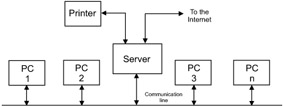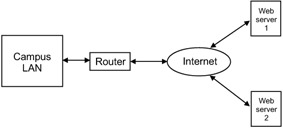1.2 Computer Systems
1.2 Computer Systems
The computer is a machine that can perform various tasks under control of the software. The programmer needs knowledge of the basic computer architecture concepts to clearly understand the structure of the computer to be able to develop solutions to problems, and to use the computer as a tool to execute the solutions to problems.
The computer system consists of two important types of components:
-
Hardware components, which are the electronic and electromechanical devices, such as the processor, memory, disk unit, keyboard, screen, and others
-
Software components, such as the operating system and user programs
All computer systems have the fundamental functions: processing, input, and output.
-
Processing executes the instructions in memory to perform some transformation and/or computation on the data also in memory. This emphasizes the fact that the instructions and data must be located in memory in order for processing to proceed.
-
Input involves entering data into the computer for processing. Data is entered into the computer with an input device (for example, the keyboard).
-
Output involves transferring data from the computer to an output device such as the video screen.
1.2.1 Hardware Components
The computer is a system in which programs (software) can execute with appropriate input data and produce desired results. The basic structure of a computer, also known as the computer architecture, is illustrated in Figure 1.1. The most important hardware components are

Figure 1.1: Basic hardware structure of a computer system.
-
The central processing unit (CPU)
-
Main memory, also known as random access memory (RAM)
-
The storage devices
-
The main input/output (I/O) devices connected to the communication ports
-
Other devices
1.2.1.1 CPU
The CPU is capable of executing the instructions that are stored in memory, carrying out arithmetic operations, and performing data transfers. Larger computers have several processors (CPUs).
| Note | In order for the CPU to execute an instruction, the program must be specified in a special form called machine language. This is a notation that is specifically dependent on the type of CPU. To execute a program, the source program is translated from its original text form into a machine language program. |
An important parameter of the computer is the speed of the CPU, usually measured in MHz or GHz. This is the number of machine cycles that the CPU can handle. Roughly, it indicates the time the CPU takes to perform an instruction. On small systems such as small servers and personal computers, the CPU is constructed on a tiny electronic chip (integrated circuit) called a microprocessor. This chip is placed on a circuit board that contains other electronic components, including the memory chips. Two typical CPUs found in today's personal computers are the Intel PentiumTM 4 with 2.4 GHz and the AMD Athlon XPTM 2400.
1.2.1.2 Main Memory
The main memory of a computer is also called random access memory (RAM). It is a high-speed device for temporary storage of data and programs. Memory consists of a large number of storage cells; each one is called a memory cell. A very small amount of data or program instructions can be stored in a memory cell. Each of these cells has an associated memory location, which is known as a memory address. When the CPU needs to fetch some data from memory, it first gets the memory location of that data, and then, it can access the data.
In most computers, the smallest unit of storage is called a byte. Every memory cell can store a byte of data or program. Memory capacity is measured by the total number of bytes it contains, typically about 512 megabytes (MB).
Another important characteristic of main memory is the access time. This affects the performance of a computer system if the amount of data to store or retrieve to and from memory is large. The access time is the time interval that the CPU takes to fetch some data from a memory cell, or to store some data to a memory cell. Main memory is considered a nonpermanent storage device; all data and programs in memory are lost when the power is disconnected.
1.2.1.3 Storage Devices
There are other storage devices that are used to store programs and massive amounts of data; these devices are the disks and tape units. They provide permanent storage until the user decides to erase the data and/or programs. The unit of capacity for these devices is the byte, usually megabytes (MB) and gigabytes (GB). A typical hard disk can have a storage capacity of 60 GB. These storage devices are much slower than main memory; the CPU takes much more time to access data on a disk device than data on main memory. Compact discs (CD) devices are based on laser technology, and are smaller in size and capacity compared to hard disks; they provide a very convenient media to transport data and programs to computer systems.
Magnetic tape devices are much slower than disks but are less expensive and more convenient to exchange data and/or programs between different computers. These devices are used mainly to back up large files or databases on larger computers. Magnetic tape devices are serial devices because the access is sequential only. To access some data anywhere in the magnetic tape, the unit must be fast-forwarded to the position of the specified data. The various disk and tape devices are connected to the disk and tape controllers (see Figure 1.1).
1.2.1.4 Input Devices
Input devices are hardware units for entering data and/or programs into the computer. On a personal computer, the main input device is usually the keyboard. The user types the values of data required by the program on the keyboard. A storage device such as a disk can also be assigned as an input device. The mouse is a pointing device that is indirectly used as an input device. A modem is a communication device that can also be assigned as an input device.
1.2.1.5 Output Devices
Output devices are the units for transferring data from inside the computer to the outside world. The main output device is the screen, the video unit. With this device, data is sent from inside the computer to the screen for the user(s).
In most applications, the input and output devices mentioned are used when the program maintains a dialog with the user while executing. This computer-user dialog is called user interaction. The input and output devices are connected to the communication ports in the computer (see Figure 1.1). For graphic applications, a video display device is connected to the graphic controller, which is a unit for connecting one or more video units and/or graphic devices.
1.2.1.6 Other Devices
Additional hardware devices include floppy disk drives, CD-ROM drives, mice, scanners, digital cameras, microphones, speakers, modems, and others. Diskettes are the most popular portable media for permanent storage and exchange of small amounts of data and programs. The standard capacity of a diskette is 1.44 MB. The compact disc read only memory (CD-ROM) is another portable media for storing data and/or programs. The capacity of a CD-ROM is about 650 MB. A similar device is the CD-Rewritable (CD-RW). These CD media can be erased and reused.
All the hardware components are interconnected via electronic paths called a bus. Data and controlling signals are normally transferred to or from the CPU to the appropriate device through the bus. The speed capacity of the bus is another important parameter that affects the overall performance of a computer system.
1.2.2 Computer Networks
A computer network consists of two or more computers interconnected in such a way that they can exchange data and programs. On a small network, sometimes known as a local area network (LAN), several small computers are connected to a larger computer called a server that stores the global files or databases and may include one or more shared printers. A local area network is limited to a relatively small geographical area, such as a building, a floor, or a university campus. Figure 1.2 shows the simplified structure of a local area network. This example is a client-server system with one server.

Figure 1.2: Basic structure of a local area network.
A wide area network (WAN) covers a large geographical region and connects local area networks located in various remote places. The Internet is a public, international wide area network.
1.2.3 The Internet
The Internet is an international network of smaller networks. On a university campus, a typical user is connected to a computer on the campus local area network. Access to the Internet is provided through a special communication device called a router. Figure 1.3 shows this type of connection to the Internet.

Figure 1.3: A LAN connected to the Internet.
The Internet provides various services, the most common of which are electronic mail, remote login, file transfer, and the World Wide Web. The Web allows the sharing of information across the Internet to be very convenient and simple. It is based on the concepts of hypertext and hypermedia.
Hypertext presents the documents in such a way that they can be linked according to the user needs. Hypermedia allows the inclusion of other media, such as graphics, animations, video, and sound.
Web servers host various types of documents, and a Web browser, which is a software component installed in a client machine, can load, format, and display a Web document. These documents are formatted using the HTML language, which is a notation that allows the Web browser to display the document. Java programs can be embedded in HTML documents and executed by the Web browser.
Every computer connected to the Internet has a unique Internet Protocol (IP) address, or Internet address. This address can be represented symbolically by the computer name and the domain name. For example, a symbolic Internet address is:
cs3.kennesaw.edu
1.2.4 Software Components
The hardware components are driven and controlled by the software components. The software components consist of the set of programs that execute in the computer. These programs control, manage, and carry out important tasks.
Figure 1.4 illustrates the general structure of a program. It consists of:
-
Data descriptions, which define all the data to be manipulated and transformed by the instructions
-
A sequence of instructions, which defines all the transformations to be carried out on the data in order to produce the desired results

Figure 1.4: General structure of a program.
There are two general types of software components:
-
System software
-
Application software
The system software is a collection of programs that control the activities and functions of the various hardware components. An example of system software is the operating system, such as Unix, Windows, MacOS, OS/2, and others.
Application software consists of those programs that solve specific problems for the users. These programs execute under control of the system software. Application programs are developed by individuals and organizations for solving specific problems.
EAN: 2147483647
Pages: 184